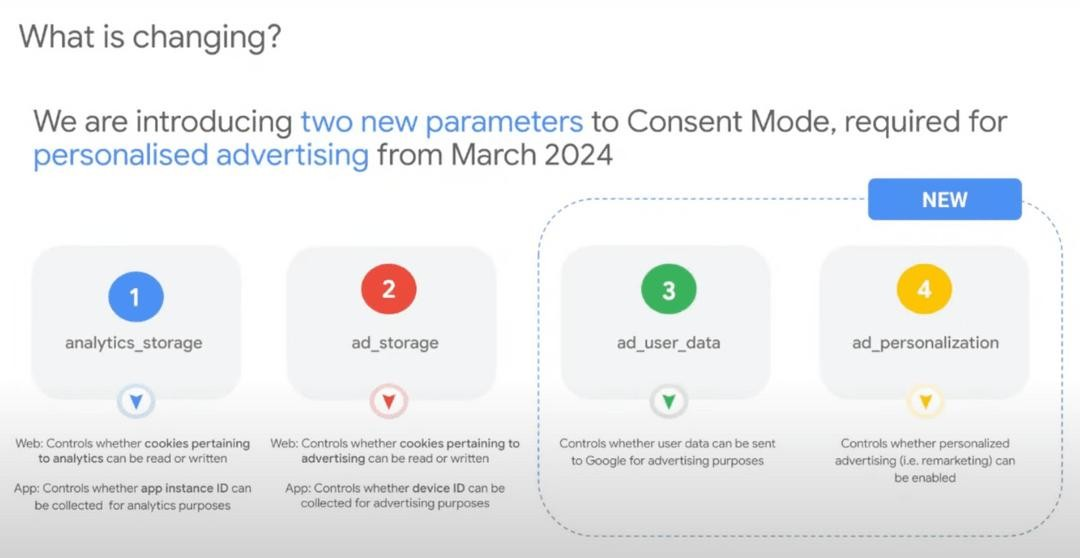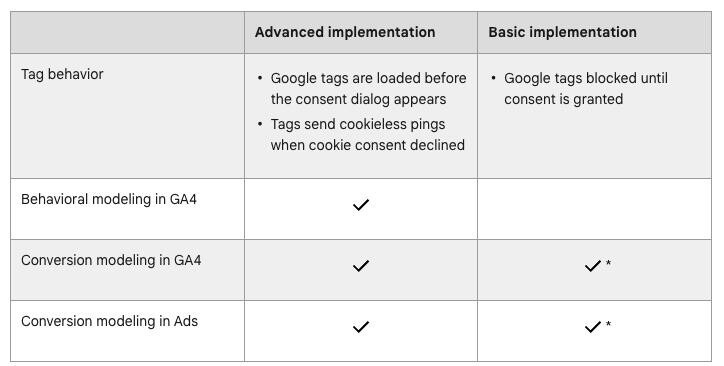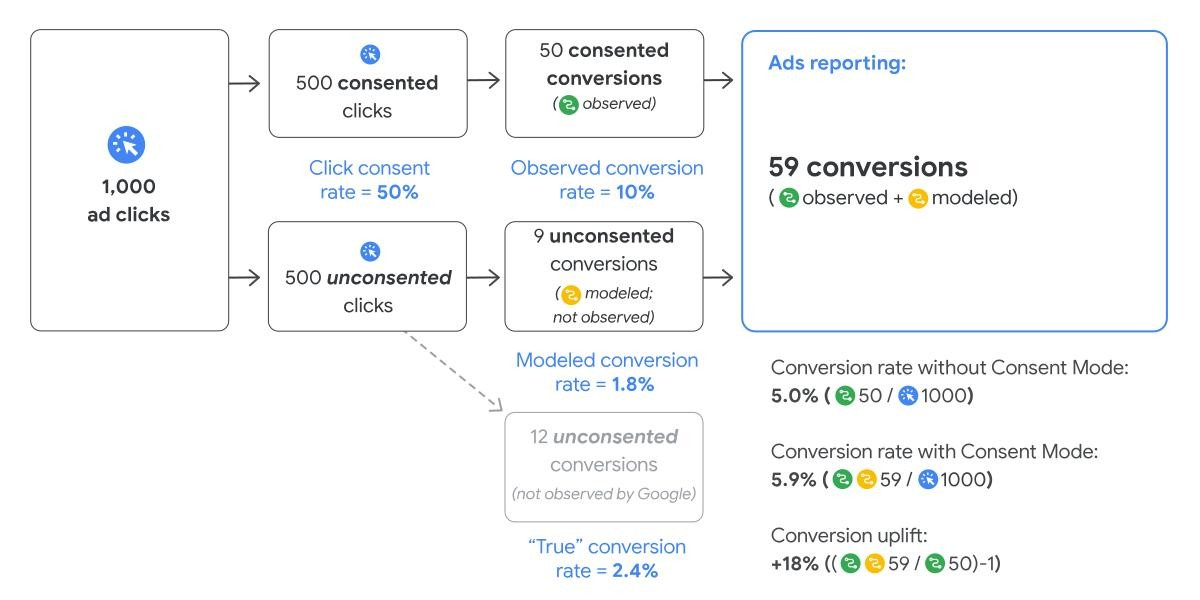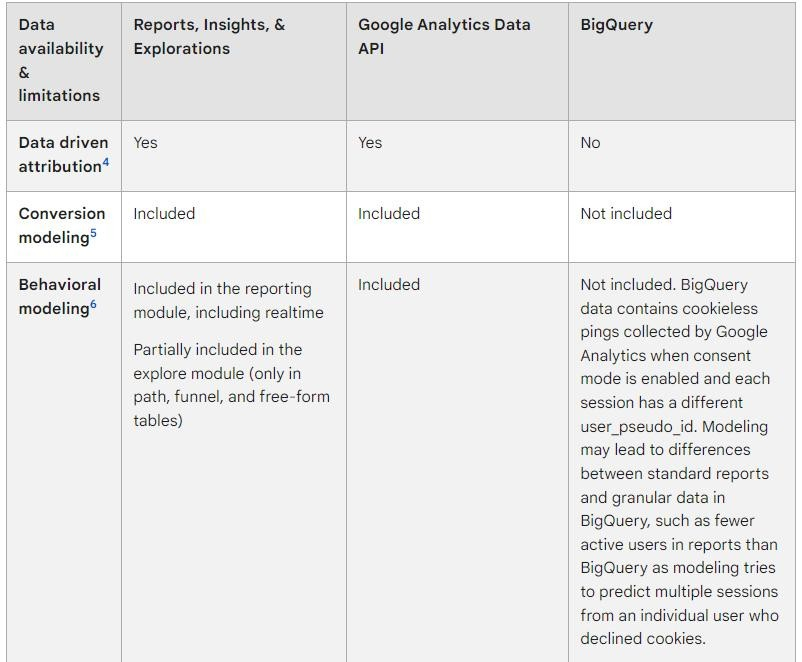Google Consent Mode v2: What does it mean for your data?
The Key Questions Answered:
- What is Google Consent Mode v2?
- How should you implement it?
- How does it impact your data modeling?
- Where should you now get your Digital Analytics data from?
March 6th 2024 marked a significant milestone in how businesses gather and process user data with the introduction of Google’s Consent Mode (V2).
This detailed exploration delves into the updates brought by Google Consent Mode (V2), examining its effects on digital analytics and the essential adjustments that organisations must make to align with contemporary digital practices, thus ensuring they remain competitive and compliant in this evolved data environment.
Understanding What’s New With Google Consent Mode V2

Source: Google
Google has introduced two new parameters in Consent Mode V2, adding them alongside the existing analytics_storage and ad_storage parameters:
ad_user_data: controls whether user data can be sent to Google for advertising purposes.ad_personalization: controls whether personalized advertising (remarketing) can be enabled.
These new parameters are specifically designed to enhance user privacy. The settings determine if personal data is sent to Google based on user consent, applicable to services like Google Ads, Google Shopping, and Google Play, etc.
Basic vs. Advanced Consent Mode V2 Implementation
There are two levels of consent mode implementation.
In its more basic form, you could choose to implement consent mode by blocking Google tags until the consent dialog appears and users consent. However, by doing this you will not get the full benefits of consent mode. For example, you will not get modelled data in your GA4 property to fill in the gaps for the missing observed data when users decline consent. Whether you choose to block tags (basic implementation) or unblock tags (advanced implementation), Google tags adjust their behaviour based on your users’ consent state. See the difference between advanced and basic implementation for consent mode:
 Source: Google
Source: Google
- When tags are blocked due to consent choices, no data is collected, and conversion modelling in Ads is based on a general model. The models use features such as browser type, conversion action type, time of day, and other high-level, non-identifying variables.
Requirements for data modelling in Google Ads
In order for modelling conversion data to be available in Google ads, consent mode needs to be set up correctly. A daily ad click threshold of 700 ad clicks over a 7 day period, per country and domain grouping is also required.
Only when both of these criteria are met will Google’s models enter training periods. From then on you’ll expect to see conversion flow into your conversion reporting and are likely to see improvements in reported performance.
How are conversions modelled in my Google Ads reports
If you are using the advanced implementation of consent mode, the tags will send cookieless pings when consent is declined. This ping will tell the Ad platform that consent was rejected and it might be subject to data modelling.
Google has found that user conversion rates vary based on user consent status, with consented users 2-5x more likely to convert than unconsented users. Factors such as consent rates, industry and conversion types can result in differences.
The example below shows that with an even split of consent vs. unconsented clicks, the conversion rate of observed conversions is 10% vs an unconsented conversion rate estimated to be 1.8%.
The overall reported conversion rate in this example would be 2.4%

There are benefits for modelling online conversions, for example;
- It allows for a more complete view of ad performance, which should reflect a more accurate ROI from ad interactions.
- It should allow for more efficiency campaign optimisation by giving signals to Google’s algorithms to adjust their bidding decisions for incomplete information.
Observed vs Modelled data
Before we understand what this means for digital measurement partners such as Google Analytics (GA4) and the accuracy of the reporting, let’s firstly outline what is known as observed vs modelled data.
When visitors arrive at your site and consent to the use of Analytics cookies, or when they opt not to disable ad personalisation within their Android device settings, Analytics can then associate user activities with specific identifiers, ensuring a seamless measurement process. This type of information is identified as ‘observable data,’ sourced from individuals who have permitted Analytics to track their activities.
However, when visitors decline to provide their consent, individual events cannot be linked to a consistent user ID. Consequently, if Analytics registers 10 page views, it is unable to determine whether these views were by ten distinct users or a single user repeatedly visiting. In such cases, Analytics employs machine learning to make educated guesses about the users’ behaviour, based on insights gathered from users who have consented to analytics cookies or similar identifiers within apps.
The training data used for modelling is based on the observed user data from the property where modelling is activated.
In principle this is not limited to just GA4. Other marketing platforms such as META, Snapchat, TikTok will be utilising similar modelling techniques to report on conversions it cannot observe through consent. These conversions and their value will already feature into your conversion value reports in the respective platforms.
Differences in reporting between GA4 & BigQuery exports
Reports, explorations, the Google Analytics Data API, and BigQuery Export aren’t likely to always match, especially when modelled data has been processed.
The below tables highlight which method of data access you’ll be able to find your conversion and behavioural modelling. Some of the reports in the GA4 interface will show if modelled user behaviour has been included.
 Source: Google
Source: Google
Where should I get my Digital Analytics data from?
How you utilise GA4 reporting will vary between each organisation and is dependent on a number of factors. Below we identify the routes businesses of different sizes might want to adopt to analyse their GA4 conversion data:
-
Small Businesses: Utilise the GA4 interface directly for standard reports and insights, focusing on basic conversion metrics to understand customer behaviour. Leverage built-in analysis and visualisation tools to track and optimise campaigns without needing extensive technical resources.
-
Small Businesses: In addition to the interface, start integrating with the GA Data API for more customised data extraction and reporting. Use the API to feed data into business intelligence tools for deeper analysis and to correlate GA data with other business data sources.
-
Enterprise Business: Fully leverage BigQuery integration alongside the GA Data API for comprehensive data analysis. Enterprises can extract, store, and analyse vast amounts of GA4 data in BigQuery, enabling advanced, customised reporting and predictive analytics at scale, combining GA data with other enterprise-wide data sources for holistic insights.
Each business, regardless of their size, can escalate its data utilisation complexity according to its resource availability, technical expertise, and specific analytical needs. Small and Medium businesses can take advantage of those insights without any technical channels by using Optsi.
The difficulty of measurement
The challenge of accurate measurement is universal; no single methodology is flawless. Businesses of every size are navigating digital transformation, yet only those embracing diverse measurement tactics for both short and long term analysis will excel. In the realm of digital marketing, platforms may be modelling for the same conversions, emphasising the necessity for businesses to seek comprehensive insights. Achieving a complete view is essential for any company’s reporting and analytics ambitions to ensure informed decision-making and strategic planning.
Solution: Adopt alternative measurement techniques that aren’t impacted by attribution
In summary, Optsi would recommend that all businesses, regardless of size, should explore different measurement strategies that bypass these attribution hurdles. In a previous article, we’ve highlighted how non-attributed data could enhance digital media optimisation.
We would encourage all brands and agencies to integrate correlation analysis into their strategic processes, to help make more informed, data-driven decisions.
Get it touch to discover how Optsi’s correlation analysis feature can enhance your digital marketing decision-making and unlock greater potential. For more insights, consider how this approach can refine your strategy and drive meaningful results.
TL;DR
-
Google have introduced two new parameters in Consent Mode V2; ad_user_data (controls whether user data can be sent to Google for advertising purposes) and ad_personalization (controls whether personalised advertising (remarketing) can be enabled). These new parameters are specifically designed to enhance user privacy.
-
There are two ways to implement this new consent mode. The more basic route (blocking Google tags) will not provide the full range of benefits available with consent mode Consent Mode V2 will impact GA4’s reporting.
-
The best route to navigate GA4 reporting depends on the size of your organisation. We delve into the options, and each business (especially small & medium sized businesses) can utilise Optsi to assist The challenge around the accuracy of measurement remains universal, as no single methodology is flawless.
-
However, achieving a complete view (as much as possible) is still essential for decision-making and strategic planning, All businesses should explore strategies that bypass attribution challenges, such as the correlation analysis available with Optsi